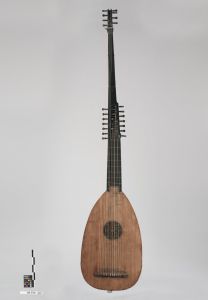It has been a while, and I got a little bit caught up in the end-of-year madness. After two days of Christmas obligations it’s great to be back at the workbench.
I’m off to a flying start. The new year will begin with some exciting projects; lutes, guitars and even the largest instrument I have ever made: a theorbe after Sebastian Schelle (Nürnberg, 1728). It’s lute with an extended neck to support the long bass strings. This one seems to be a true players instrument, rather than one made for a wealthy patron. Other than most theorbos this was made probably for D-minor tuning, like other baroque lutes.
- Schelle 1728
- Schelle 1728
- Schelle 1728
The total length is 190 cm, so it will become a little challenge in my 210 cm high workshop… Fortunately this example has some hidden features to make it easier to travel with. At the back of the neck is a hinge, making it possible to “fold” the neck. The player who ordered the instrument really likes te idea, so we’re incorporating this little gadget…

 It’s kept in the collection of the Germanisches Nationalmuseum in Nürnberg, the same city in which Schelle made it. The museum has a set of plans available for this instrument. Even the plans are huge, a sheet of paper, 250 cm long by 100 cm wide… The neighbors at the shop were very kind to offer the great hall of their farmhouse to lay it out, because it’s simply too large for any normal table…
It’s kept in the collection of the Germanisches Nationalmuseum in Nürnberg, the same city in which Schelle made it. The museum has a set of plans available for this instrument. Even the plans are huge, a sheet of paper, 250 cm long by 100 cm wide… The neighbors at the shop were very kind to offer the great hall of their farmhouse to lay it out, because it’s simply too large for any normal table…
I’m currently reading up and studying the history and many varieties of theorbo available. The instruments, as well as the people who made them. Like the works of Schelle’s contemporaries, Martin Hoffmann, Leopold Widhalm and Joachim Tielke.
In the collection of the same museum is an earlier theorbo by Matthias Alban (Bolzano, 1704) which shows striking similarities in soundboard dimensions and shape…
- Alban 1704
- Schelle 1728
- Alban 1704
- Schelle 1728
- Alban 1704
- Schelle 1728
Would Schelle perhaps have seen this instrument and used it as a basis for his version? We will probably never know.
 Schelle and his successor Leopold Widhalm are famous for their “german theorbo” with the swan neck. They made these instruments and ‘updated’ existing instruments by other makers. There is a very nice article about this by Klaus Martinus here (pdf).The most famous example is the Laux Maler, also kept in the Nürnberg collectiom, which has a neck and pegbox by Schelle.
Schelle and his successor Leopold Widhalm are famous for their “german theorbo” with the swan neck. They made these instruments and ‘updated’ existing instruments by other makers. There is a very nice article about this by Klaus Martinus here (pdf).The most famous example is the Laux Maler, also kept in the Nürnberg collectiom, which has a neck and pegbox by Schelle.
These conversions were very common. A lute would be updated to follow changing musical fashions. Especially the works by the early Bolognese masters Laux Maler and Hans Frei were much revered and sought after.
The Dutch scholar and diplomat Constantijn Huygens (an avid lute and gamba player as well) was corresponding with players like Gaultier and Foscarini and asked them to look out for a Maler or Frei lute with nine ribs. Click here for a nice article about this. Further on they speak about lute makers who can do the conversion. These lutes are like the vintage instruments of today. Often fetching ten times the price of a new instrument. Like the “holy grail” Gibsons and Fenders…
For me making this instrument is a dream coming true. I never imagined getting a commission for a theorbo so soon. And especially this unique instrument for a young and very knowledgeable player.
So stay tuned, for it promises to become a rather LONG story…
















I like the carved rose.
LikeLiked by 1 person